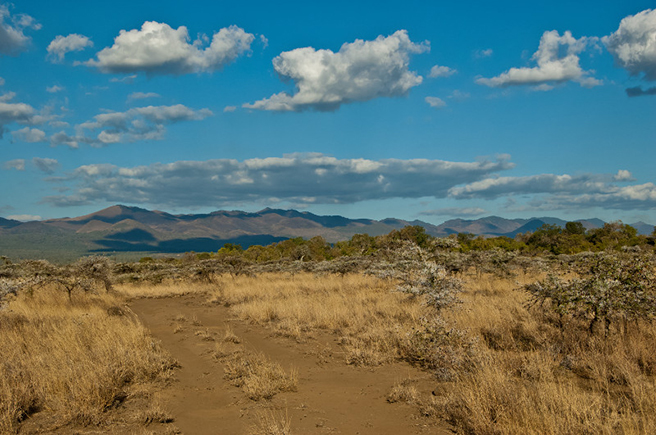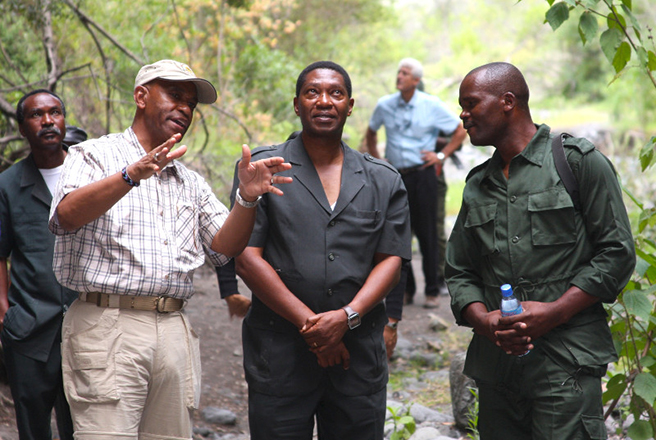The Use of REDD+ in Achieving Conservation Goals

AWF’s climate change programme focuses on both climate mitigation and adaptation and the inclusion of climate-related impacts into AWF’s entire conservation planning framework. The development of Reducing Emissions from Deforestation and Forest Degradation (REDD+) projects, while not the entirety of AWF’s climate change efforts, is nevertheless an important tool in achieving these goals.
REDD+ projects involve the development of new or improved livelihood activities that will reduce community dependence on consumptive forestry activities and consequently protect the forests within which communities live. The reduction in the amount of carbon emissions by the community is measured and “sold” as carbon credits to organisations wishing to offset their own carbon emissions. The sale of these “credits” directly profits the participating communities through a predetermined carbon benefit– sharing mechanism.
In addition to reducing emissions of carbon dioxide into the atmosphere, REDD+ projects also help build ecosystem and human resilience to the harmful effects of climate change.
Project in Chyulu Hills
As mentioned, REDD+ is a tool for climate change mitigation—not an end in itself. AWF is very selective about the REDD+ projects we engage in. The projects must help us realise specific conservation targets, such as protecting a water catchment or a wildlife corridor. For us, there is little point in embarking on a REDD+ project if the project does not meet our other conservation goals.
In August 2013, AWF and a consortium of partners embarked on a project to incorporate the entire Chyulu Hills ecosystem into a REDD+ project. Located in southeastern Kenya, the 420,000-hectare project will seek to protect the Chyulu Hills cloud and lava forests and surrounding savanna woodlands for the next 30 years. The project encompasses the Chyulu Hills National Park; parts of Tsavo National Park; Rombo, Imbirikani and Kuku Group Ranches; and land owned or managed by the Kenya Forest Service, the Kenya Agricultural Research Institute and the David Sheldrick Wildlife Trust.

AWF is working with a large consortium of partners on this project. They include the Kenya Forest Service, Kenya Wildlife Service, the Kenya Agricultural Research Institute, Big Life International, the Maasai Wilderness Conservation Trust, Conservation International, the David Sheldrick Wildlife Trust, and Wildlife Works. Each of these partners has an extensive history in the area.
The project is expected to generate carbon emissions reductions, which will be sold, with the revenue re-invested into projects to help the protection of the Chyulu Hills water catchment, ensuring its survival for the future. This is a critical step for securing the ongoing provision of water services and the continued flow of water to the estimated million downstream users of the Mzima Springs pipeline, including the city of Mombasa, on Kenya’s coast. “If we don’t secure the Chyulus using innovative means like REDD+, it is likely that the very foundation for economic development in Kenya, namely water, could dry up in the next few years,” says Rob Dodson, vice president for African field operations for Wildlife
In addition, the projected positive impacts for biodiversity and job creation are intended to significant- ly augment the ongoing activities of the partners. The Chyulu Hills study area lies between two major parks, Tsavo and Amboseli, and this project therefore will help protect a significant wildlife corridor. Further, small to medium-scale enterprises will be set up to enable the communities to improve their livelihoods whilst protecting the forests and woodlands in the region.
Some lessons learned
The funds from the sale of carbon credits will be distributed to the communities, which will reinvest them in a variety of projects determined by the community representative body. These could be conservation or community-based projects. This is one of the lessons AWF has learned from our work on our first REDD+ project in the Kolo Hills in northern Tanzania.
When AWF first embarked on a REDD+ project there, the price of carbon was relatively high, and the potential benefits from carbon were expected to be reasonably high. Now, the cost of carbon has dropped, reducing potential individual household payments to very little. By pooling the payments into community-based disbursements, the monies can support one or more significant projects, such as a community school or the salaries of forest or game scouts.
Regardless, AWF’s goal with all of our REDD+ projects is to get communities benefiting in some manner by the end of the first year, be this from carbon payments or other benefits such as improved agriculture or clean energy. It is helpful that the Chyulu Hills project is much larger than what we embarked upon in Kolo Hills and that more carbon per hectare is expected to be made available for sale.
The Chyulu consortium has initiated data collection and fieldwork activities and aims to seek validation for the project within the next six months.